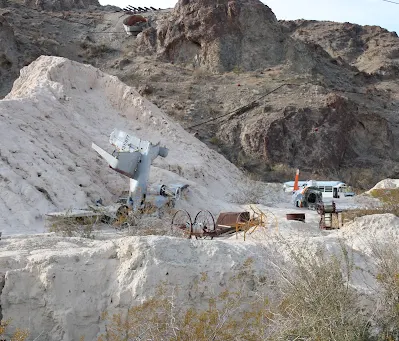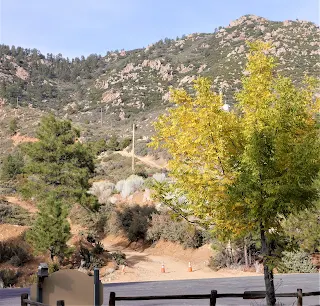Years ago, Laureen and I sat down to watch the 2001 film, 3,000 miles to Graceland one evening. Not sure why, but we are fans of Kevin Costner and Kurt Russell and decided to give it a shot.
We like doing that - watching a film on a shot.
Most end up as a 22 caliber plink but some end up as a full blown 44 caliber full-metal-jacket blast. While on the subject, may I mention Top Gun Maverick? That was, in my opinion, a macho-side-winder-missile of a film. But I digress.
The Graceland film was probably, in my ‘Beyer what round would this film rate’ opinion, would be a solid 40 caliber. Enough to do damage but not enough to awaken neighbors three doors down.
I am not sure why I am using such terms to determine the strength of a film but perhaps since I recently went to a legal shooting range with a few friends, the aroma of gunpowder is still circulating through my senses.
Anyway, Laureen and I drove to the film location for one of the scenes in the film - the ghost town of Nelson in Nevada.
This is where Costner, as nasty as his character is, flicks his lit cigarette out of the car and blows up the place, sending a couple of full sized planes right into the air.
Sections of the planes are still there, with one sticking right out of the ground as though it crashed nose first.
 |
| Destroyed aircraft from film 3,000 Miles to Graceland in Nelson, Nevada |
Really cool.
Unlike most ghost towns I visit, Nelson is a bit different. Not the average ghost town where buildings are there but mostly not. Rumors of past lives are envisioned across desert landscapes or remote mountain valleys. No, Nelson is unique in that aspect.
As we drove through the eleven miles of desert toward Nelson off the 95 and on the 165, there were a lot of Joshua trees, creosote bushes, cacti, and other plants which I cannot possibly name.
“Beautiful area,” Laureen mentioned.
“Some folks think the desert is boring,” I replied. I had actually heard someone say that once, but then again they also did not believe Sasquatches existed.
“Then they have not traveled much,” Laureen said.
Besides being one of the settings for a movie about a bunch of Elvis impersonators about to rob a casino in Las Vegas, the town of Nelson has a fascinating history.
A long detailed history of exploration, riches, murder, and all the other ingredients that make visiting such a place a must.
We suddenly came into view a collection of modular homes, stick built homes and lots with no homes at all. In fact, some of the homes were large and beautiful.
“Are we there?” I asked.
“We just passed a sign that indicated we had arrived in Nelson,” Laureen replied.
This was not a ghost town at all. Folks walking around, doggies prancing in front yards, people driving modern cars instead of horse and buggies, and not a ruin in sight.
“I think we’ve been bamboozled,” I uttered.
Nope, the ghost town was about another mile or so past the present and very much alive village of Nelson.
In 1775, a group of Spaniards were walking here and there about this locale when they discovered pockets of rich ore containing large amounts of gold.
Immediately they called the area, El Dorado, which in Spanish meant any place where riches, opportunity, or abundance of things can be found. And this, El Dorado, was such a place just west of the rushing Colorado River.
After the Spaniards left, the area was searched now and then, but in 1859 large lodes of both gold and silver were discovered and El Dorado came into full force, creating one of the largest mining booms in Nevada state history.
It seems that every time I conduct research about a mineral strike, it happens to be one of the largest in that particular state.
“We got us another boom,” one old miner may have said to another.
The other miner may have nodded his unkempt bearded head. “Yes, and last week I was at another boom over yonder.”
Two years later the rush for riches was truly on and a steamboat landing was created at the mouth of Eldorado Canyon at the shore of the Colorado River to transport goods to the quickly forming town and to take the rich ore south along the river.
 |
| The ore would be transported nearby on the Colorado River |
The first name for this mining bonanza along the Colorado River was Colorado City. Must have taken moments to come up with that name. Then it was changed to simply Eldorado.
It should be noted that this was before any man made dams were along the length of the Colorado River and thus supplies and riches could be transported nearly 350 miles from this location all the way to the Gulf of California.
Try that today. In fact don’t…unless you feel like dragging your boat out of the water in front of Hoover Dam, Davis Dam, and the Dam Dam.
With money rolling in from the various mines in the area, the town of Eldorado continued to grow and one of the richest was the Techatticup Mine which produced millions of dollars from gold, silver, copper, and lead.
 |
| One of the canyons leading to riches in Nelson, Nevada |
And with all such boom towns, another element came to town - hooligans.
Yes, Tom Hooligan moved to Eldorado in 1897. Okay, I may have made that name up, but bad hombres and bad hombres showed up, making the mining camp a very dangerous place to reside.
Since Eldorado Canyon was so narrow and yet so rich in mineral deposits routine, arguments arose between miners, and murder became a way of life. And, add to that fact that the Civil War hadn’t ended that long ago, deserters from both the Union and Confederate armies migrated there believing the location in Nevada was so isolated they would not be hunted down by the authorities.
Of course, there were no animus feelings between those two factions at all. Did I mention that murder became a fact of life?
A town was eventually built further up the canyon away from the rushing river since that area had seen the building of a stamp mill and docks for the steamships that would visit Eldorado on a routine manner and had become too crowded.
In 1897, a prospector and camp leader by the name of Charles Nelson was found murdered in his home, along with four other people. The killings were blamed on a Native American by the name of Avote. The town’s name was then changed to Nelson in his honor.
Nelson was a different sort of mining camp, in which the majority see their boom last a few years at most and then dry up. No, this locale produced rich minerals from its founding all the way until 1945.
Around 1901 to 1905, railroads were becoming more and more accessible for the citizens of Nelson to move products and soon there was no longer the need for the steamboats along the Colorado River. It was faster and cheaper to bring goods in or ship out the needs of the mining boomtown by rail.
In 1907, the post office closed in Eldorado and was moved to Nelson.
As we walked around the now eclectic ghost town of Nelson, we marveled at the displays of vintage automobiles and trucks scattered everywhere. Some were parked along the only paved road through town. Some were parked in dirt parking lots in front of original buildings from the heyday of Nelson. Some were just parked as though the owner had just exited the vehicle to carry on some business in a nearby structure.
 |
| Some strange looking vehicles in Nelson, Nevada |
There are signs indicating that this isn’t just a ghost town but a town where people live. The wording on the signs are clear - ‘Leave before Dark.’ The residents do not want tourists trampling all over private property looking at this or that artifact.
 |
| John R Beyer standing in the doorway in Nelson, Nevada |
It was a wonderful couple of hours we spent trampling around - it was early in the morning. The gift shop/visitor center was open and we chit-chatted with a woman running the place. She mentioned that mine tours are available and reservations can easily be made by visiting the Eldorado Canyon Mine Tours website. Not only can the guests visit the actual mines in the area which produced the boom, but the tour also incorporates visiting film sites, wedding venues, great photo opportunities, and overall explains the entire history of Nelson.
 |
| The main street in Nelson, Nevada |
In fact, we watched as three or four small tour buses entered the small town and deposited tourists for their day of adventure.
It was windy, so we decided to pack it in and head west, knowing we would be back to explore much more of this Eldorado Canyon.
For more information: https://www.eldoradocanyonminetours.com/index.html
John can be contacted at: beyersbyways@gmail.com






















